| Cover
Story
An Uncertain Future
Salma, an 18 year old girl has two sons and used to work in a garment factory in Mirpur. That fateful morning, her younger boy had asked her for an ice cream. She was a little pressed for money so she said that she would treat both her sons to some generous serving of ice cream when she got back from work. That day changed her life forever. During work, a fire broke out at the factory building. There was a sudden rush of panic and almost all at once, everyone around her started screaming and rushing about. She somehow made her way to the main gate, only to find a crowd of her co-workers gathered there, all screaming for the guards. She then discovered that the main gate was locked and the on duty guard was nowhere to be seen. Her panic reached its vertex when she discovered that two girls from her production line had caught on fire. That sight froze her muscles. She was then confronted with another harsh reality: she could not breathe! Her lungs finally gave up and she fell to the floor unconscious. She woke up in a hospital, with bandages all over her body. She had severe fire burns on both her legs and the skin from hands had separated from the bonus. She will never be able to work again. Aided by a cane and her two sons, she went back to the factory for compensation. But her name had mysteriously vanished from the factory's register. She is presently without work due to her physical disability and does not know how she will feed her two sons.
Imran H. Khan and Shamim Ahsan
The ready-made garments (RMG) industry of our country has boomed since its start 25 years ago. It tells a story of success, determination and our spirit of hard work that has put us on the world map for garments and knit wear. It is quite disturbing when we take a closer look at the costs of such success. The people who work in our garment factories, most of whom are women, have to work in the most hostile of environments. Women workers are paid much less than their male counterparts doing the same work and are sometimes over burdened with extra work, with little or no overtime. They work in congested, unsafe and unhealthy conditions. Such is the harsh reality that every garment worker has to wake up to each and every morning.
 Factory labourer Abdus Salam, aged 45, is a fire victim from KTS Textiles in Chittagong. He and four other of his female co-workers have been languishing at the Burn Unit of Dhaka Medical College and Hospital (DMCH) for weeks, after being brought here from Chittagong. He used to get a salary of Tk 3,000 and would send half of it to his village for his wife, two daughters and a son. The family now faces an uncertain future as Salam, the family's lone bread-earner has been severely burnt in the accident. "My daughters have grown up. I do not know how I will marry them off," says Salam's helpless wife Shamsunnahar. Factory labourer Abdus Salam, aged 45, is a fire victim from KTS Textiles in Chittagong. He and four other of his female co-workers have been languishing at the Burn Unit of Dhaka Medical College and Hospital (DMCH) for weeks, after being brought here from Chittagong. He used to get a salary of Tk 3,000 and would send half of it to his village for his wife, two daughters and a son. The family now faces an uncertain future as Salam, the family's lone bread-earner has been severely burnt in the accident. "My daughters have grown up. I do not know how I will marry them off," says Salam's helpless wife Shamsunnahar.
Lying helpless on another bed is Farzana Begum. A large part of her body, including the face, throat and legs, has been seriously burnt in the same fire. Farzana had gone back to her father's family after her husband deserted her a year ago. There she found that her young brothers and sisters were trying to maintain the family doing odd jobs as their father was too old to work any more. The little kids, however, could not earn enough for even two meals a day. Finally, a desperate Farzana came to Chittagong and joined the garment factory. But her desire to earn enough to support her family came to an end last month when the devastating fire disabled her for life. "Doctors say I will recover, but they keep silent when I ask if I will be able to work again," Farzana says.
The same uncertainty and worry have haunted hundreds of poor helpless garment workers over the last decades. There seems to be no end of it.
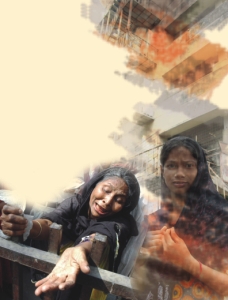 Various organisations are constantly at battle with the authorities to make the lives of such workers a little better and safer. Make Trade Fair (MTF) Alliance Bangladesh started its journey in April 2002. It is an integral part of the global MTF Campaign and comprises of a platform of non-government organisations (NGOs), research organisations, trade unions of the RMG sector and others. Oxfam was the initiator of this campaign and the alliance, while different organisations such as INCIDIN Bangladesh, PROSHIKA, BLAST, Karmojibi Nari, BELA and others soon came into the picture and started working at different levels for the campaign. Some of the major issues in MTF's Campaign include: livelihood security of RMG workers, specially the female workers; market access for the Least Developed Countries (LDCs) and special and differential Treatment of the LDCs. Various organisations are constantly at battle with the authorities to make the lives of such workers a little better and safer. Make Trade Fair (MTF) Alliance Bangladesh started its journey in April 2002. It is an integral part of the global MTF Campaign and comprises of a platform of non-government organisations (NGOs), research organisations, trade unions of the RMG sector and others. Oxfam was the initiator of this campaign and the alliance, while different organisations such as INCIDIN Bangladesh, PROSHIKA, BLAST, Karmojibi Nari, BELA and others soon came into the picture and started working at different levels for the campaign. Some of the major issues in MTF's Campaign include: livelihood security of RMG workers, specially the female workers; market access for the Least Developed Countries (LDCs) and special and differential Treatment of the LDCs.
Accidents in garment factories are one of the most occurring incidents in Bangladesh. To commemorate International Woman's Day, the Make Trade Fair Alliance held a mock trial of some cases of women garment workers who have been victims of factory disasters. The mock trial, held under the banner 'Women Labour in the context of Occupational Hazard and Safety and Security,' took place in a mass hearing on March 7 in Rabindra Sarobor's open theatre. About a thousand people gathered in the evening for the public hearing, including people from various NGOs, hundreds of garment workers and their families.
Different clauses of penal code, criminal act, factory law and the constitution were brought into light and the lawyers, representing the garment workers, demanded exemplary punishment for the guilty. They accused the Chief Inspector of Labour Ministry for not visiting the factories and making sure that the work environment was safe. The lawyers also accused RAJUK (Rajhdhani Unyan Kartripokkho) for the construction and extension of illegal structures and for not visiting the site after its completion for verification purposes. The owners of factories were accused of violating factory law and safety and security acts. Such negligence was inexcusable; the lawyers also stated that
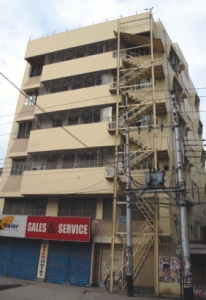 A large number of garment factories are housed in buildings that were constructed for residential purposes. They were not meant to stand the load of thousands of garment workers |
they termed such activities as prime examples of human rights violation. In their symbolic verdict, the judges, namely of Justice Rtd. Nizamul Haque Nasim and Dr. Hamida Hussain awarded the factory owners, the general managers, the security personnel and the guilty government officials' five years of rigorous imprisonment and imposed heavy fines on them. The judges then directed the government to amend the laws regarding the compensation for the victims and their families and to ensure that the workers had a safe working environment. The judges also held BGMEA (Bangladesh Garment Manufacturer and Exporters Association) and BKMEA (Bangladesh Knitwear Manufacturers and Exporters Association) responsible for not taking strict actions against the owners of certain factories who are breaking laws each and every day. They also asked the government to take measures to relocate garments and knitting factories to the outskirts of cities. It is up to BGMEA and BKMEA to make sure that all its workers are well aware of all the laws that are to be obeyed and that they know what rights they have as well. They also opined that the compensation due to death should be Tk 10 lakhs and the compensation for the severely injured should be Tk 5 lakhs. In reality, neither the garment factory owner, nor any other government agencies entrusted with the task of overseeing if the garment factories are built and run according to laws, has to face trial. The result is a continuation of frequent accidents, deaths, injuries and destruction.
The latest in the series of accidents was the fire in KTS Composite Mill in Chittagong which left 63 people dead and rendered many others disabled for their entire life. And as newspaper reports suggest many of the deaths could have been averted if the main gate of the factory had not been under lock and key. Haven't we heard the same thing many times before - the main gate was locked? The doors, however, remain closed to [allegedly] prevent pilferage of factory property.
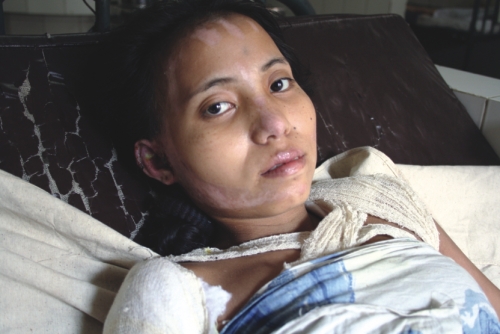
One of the many victims of the KTS fire incident who still suffers at DMCH
Sometimes however it's not the gate but faulty construction that causes the accident. More than twenty workers were crushed alive and about 50 were injured in Phoenix Garment building that collapsed on February 25. In that case as well as the case of the nine-storey Spectrum building in Savar on April 11 of last year, which killed 62 garment workers and injured hundreds, Rajuk was quick to point out that the structures were either partially or completely illegal. The owners had apparently not complied with the construction laws set by the Bangladesh government. In the Spectrum building case, the then Officer-in-charge of Savar Police Station filed a case against the owner of the building and Managing Director of Shahriar Group Mohammad Shahriar, and Director of the company Mohammad Hashem Fakir. Both the accused surrendered to the court just two weeks later and in the third week, were released on bail. The case was later handed over to the detective branch (DB) that, till today, has failed to submit any charge sheet. The dates for hearing the case have been deferred several times over the last ten months on the grounds that DB is yet to submit its report.
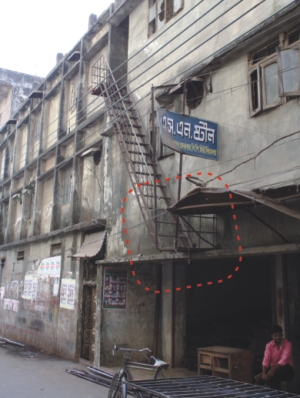
While some of the garment factories have emergency escapes, more often then not those are too narrow for the panicked workers to rush down. This particular escape stairway does not even reach the ground |
Accidents at the garment factories are taking place frequently say leaders of numerous human right organisations. MTF leaders state that garment workers die mostly during the incidents of fire as the entry and exit points are kept locked during working hours. They also blamed the government for not taking stern action against the offenders. They estimated that since 1990 around 70 major accidents have occurred in the garment factories that left around 400 workers dead and a staggering 4,000 severely injured. As there is no official figure regarding the number of casualties in fire, the death toll so far has been based on media reports. MTF leaders demanded that the government form a task force to monitor workplaces inside the factories to ensure a fire security system, the appropriate weight capacity and storage system. "Accidents have been occurring one after another across the country but the government did not take stern action against the owners of the garment factories who violate the rules," said Shirin Akhtar, president of Karmajibi Nari during the mock trial. Leaders of the MTF alliance also demanded deployment of women Ansars at the factories to ensure security for workers, as 85 percent of them are women.
What is the relevant government body doing?
Though hundreds of lives have been lost and numerous others have become disabled forever in the accidents in garment factories precious little has been done to ensure safe working condition in factories.
The government's Factory Inspection Office under the directorate of labour is responsible to oversee if the factories have been built as per the rules and if they have got the essential safety measures. What is this department doing? Dr Md Serajuddin, chief inspector of factories says: "Our manpower is too limited to cover all factories and take proper steps. We are doing our best with the given logistics,".
Serajuddin reveals that only three inspectors are engaged in inspecting safety measures at as many as 15,000 factories under Dhaka divisional factory inspection office. And only 20 inspectors are now deployed to inspect around 50,000 registered factories in the country. Of them, four are working at the head office, six at Dhaka divisional office and three at Chittagong, Khulna and Rajshahi divisional offices. Some other general inspectors look into violation of laws relating to factories, workers' wages and licences of factories.
Different kinds of registered factories, including garments units, are under their supervision. Each of them is supposed to inspect at least 10 factories a month. But apart from the registered ones there are thousands of small, unregistered factories in various sectors that are not under their jurisdiction and thus run unmonitored. The number of factory inspections and cases filed are amazingly high compared to the number of inspectors. In 10 years from 1996 to 2005, factories were inspected 4,42,462 times and 10,3024 cases were filed. But that improved the safety situation very little as evident from the number of accidents.
Inspectors are often keen to file cases because when they do so, factory owners negotiate with them and make payments for withdrawal of the cases. But they hardly file cases regarding violation of safety measures, a BGMEA source says.
"I cannot remember if they (inspectors) have filed any case here for violation of safety measures in the recent past. We get cases mainly concerning wages and job discrimination," says a labour court official, requesting anonymity.
The Factories Act 1965
This clearly states that 'Doors of all the rooms of a factory, including the main entrance and exit must be kept open as long as someone is working inside.' In most cases, deaths can be prevented if this act is properly followed. 'Each of the floors in the factory must have two emergency exit doors, both of which must be at least 32 feet wide and 6 feet and 6 inches high. If more than 20 people work in a factory there will have to be an emergency exit stairway through which one can directly and without any obstacle get out of the factory.' The fire escapes in most factories are too narrow to allow more than one person to get down and the emergency doors are mostly locked with padlocks. 'The escape stairway cannot be more than 150 inches away from any part of the factory.' 'All the stairs in the factory must be at least 45 inches wide.' 'The workers cannot be allowed to work more than 48 hours a week, or more than nine hours a day.' This is also blatantly ignored as many factories make their workers work about 12 hours a day and sometimes more with little or no overtime allowance. They are sometimes made to work seven days a week if the factory needs to meet a shipment deadline.
Some of the common reasons behind the accidents
In most of the fire incidents, the casualties are high as the factories keep their main gates shut and as a result, the workers struggle to make a quick exit even during an emergency. A top official of Fire Service and Civil Defence (FSCD) said almost all the factories violate the safety rules.
On condition of anonymity, he said most of the factories keep their entrances locked, flouting the safety rules. He said many of them even lack fire exits, emergency lights, searchlight boxes with batteries and enough water to put out fires.
"Many have double stairs, but the alternative stairs usually remain occupied by goods and they do not have enough light," he said, adding that according to the FSCD law, it is mandatory for the factories to have an emergency exit to prevent casualties. But the provision is grossly ignored.
Moreover, lack of knowledge on the part of garment workers about how to use safety measures including emergency exits and fire extinguishers are also a reason behind higher causalities.
Many of the factories have emergency exits but in most cases of fire and other mishaps in the past, panicky workers did not use those and rushed to the staircase together, resulting in deaths and injuries in stampede. Because the workers did not have the necessary training on what-to-do in the event of a fire.
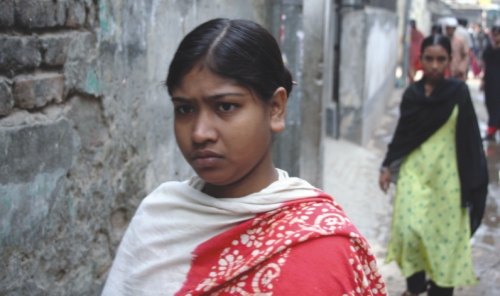
The garment workers have to walk miles to work, braving the offensive remarks of men
The Ready made Garments industry in Bangladesh has experienced an unprecedented growth over the last decade and half. The exports of the industry accounted for over 76% of Bangladesh exports earnings in fiscal 2001-2002 and provided employment to 2 million people, of whom 80% are women. It promotes the development of other key sectors of the economy, including textiles, banking, packaging, transportation, insurance and support industries. Several million more jobs in Bangladesh are linked to the clothing sector. But when it comes to ensuring a safe work environment, the picture is a dismal one, though there are numerous laws to protect the workers in this lucrative industry. "We have a very good Factories Act", says Advocate Marshia Ahmed, representing INCIDIN Bangladesh in Make Trade Fair Alliance. "All we have to do is simply follow it". Bangladesh National Building Code (BNBC) 1993 General Requirements
The access facilities for fire service vehicles and engines shall meet the following requirements:
1. Fire apparatus access roads shall have an unobstructed width of 4.5m and the minimum vertical clearance shall be 5m. The width and vertical clearance of fire apparatus access roads may be increased when in the opinion of the fire authority, the clearances are not adequate to provide fire apparatus access.
2. Fire apparatus access roads having a dead-end longer than 30m from the main road shall be provided with appropriate provisions for turning around the fire apparatus.
3. The fire apparatus access road shall be marked by an approved sign.
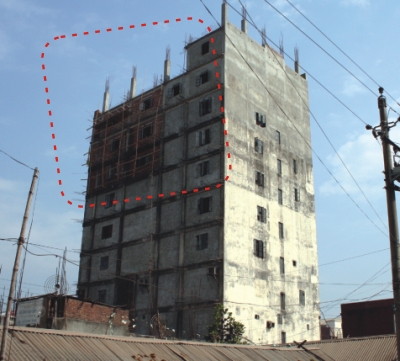 Garment factories are often extended upward without having the approval of RAJUK
Garment factories are often extended upward without having the approval of RAJUK
BGMEA Bangladesh Garment Manufacturer and Exporters Association (BGMEA), the forum of the garment factory owners, is a strong body and has a crucial role to play, specially when it comes to ensuring safe and healthy work environment in the garment factories. What has the BGMEA been doing about the gross violation of all sorts of safety rules in the garment factories? Abdus Salam Murshedi, acting president of BGMEA, claims BGMEA has been doing its best. "We have got 10 two-member teams at our Compliance and Safety Cell, which are inspecting the garment factories everyday from 3 pm to 10 pm. They file reports and in case of violation of any regulations we serve notice to the owner to fix the problem," Murshedi says.
Murshedi cites an example where the inspection team found a building in Savar's Baipal area that houses two garment factories Anzir Apparels and AL Bari Pvt Ltd -- as risky. "We conveyed our concern to them and asked them to allow our engineers examine the building as well as related documents. We also asked them to suspend work for as many days as we would need for a thorough check up," Murshedi says.
But why are so many accidents taking place if they are monitoring so closely? Most of the garment factories were situated in the city and more often than not garment factories were housed in buildings that were built for residential purposes. Most of the large and medium sized garment factories have gone in the outskirts and have constructed factory buildings following rules. But the problem is with the small units who do not have the financial capability to construct and move to their own buildings. So, they are continuing work in those risky residential-turned factory buildings, Murshedi tries to explain.
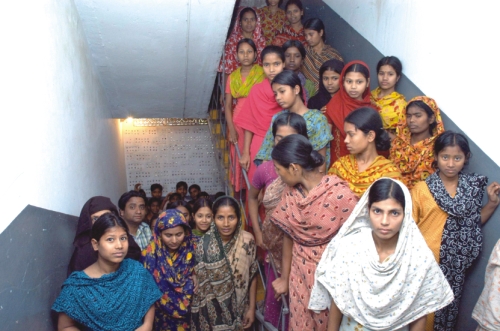
The Factories Act demands the stairs in the garment factories must be at least 45 inches wide but this particular law is grossly violated in most of the factories
The garment business leaders have long been lobbying with the government for a place exclusively for garment factories, Murshedi informs, adding that they are expecting to get an area of 100 acres a little further down the Meghna Ghat Bridge in Gojaria upazila. When the garment factories now within the city will be relocated there, the owners will automatically construct the factory building abiding by the rules. Regarding compensation Murshedi says that there should be a national policy regarding these matters including the compensation amount. "I personally believe that Tk 1 lakh is no match for someone's life. But then again the law framed years ago makes a claim of only Tk 21,000 ," he says. This law was made about 80 years ago. He also admits that it is not right that the injured are not given any compensation except for treatment cost. "They should be adequately compensated, but then there will have to be a standard system in place which we all can follow," Murshedi says.
BGMEA (Labour & Factory Law) Means of Escape In Case of Fire:
1. Each room has to have two exits and people can reach them easily.
2. Each exit door has to be 32" wide and 6'-6" high at least.
3. There should be two stairs directly down to the ground level.
4. Open sides of the stair should have handrail.
5. Stairs should be made of fire-resisting materials.
6. Every lift-way should be surrounded by fire-resisting materials and doors should be made of fire-resisting materials.
7. Emergency stair should not make an angle more than 45 degrees with the ground.
8. Stair should be with in 150 feet from the fired portion.
9. No stair should be less than 45" width.
 Make Trade Fair Alliance organised a Mock Trial to bring justice for those garment workers affected by 'accidents' |
Safety in Terms of Fire:
No door can be locked or closed tightly.
Path of the emergency exit should be indicated by large red signs.
Emergency alarm system should be provided.
Training should be given to the workers.
Should have fire extinguishers and instruments.
Fire Service and Civil Defense
1. Each floor of the factory should have Carbon Dioxide (CO2) fire extinguisher for fire caused by electricity and dry chemical powder (DCP) fire extinguisher for fire caused by other means.
2. Fire extinguishers should be refilled after regular interval and should be inspected.
3. Alternative stairs should have minimum 42" width and be at maximum 45 degrees angle.
4. Each floor of the factory should have two fire points and every point should have one water drum of 45 gallons and 4 buckets hung.
5. The door of the alternative staircase should be kept open during the working period.
6. The access to the staircase should be kept clear all the time and there should not be any goods at the access.
7. Emergency light should be provided inside the factory and the staircase.
8. Opening and closing of the door should be designed properly so that workers can pass out or in easily.
9. Electric wiring should be concealed or ducted.
10. Have to provide hose reel.
11. Have to provide smoke detector.
12. Have to provide public address system.
13. Have to have the provision of First Aid and necessary medicine.
14. Provision of stretcher for the injured people should be kept.
15. The phone number of the fire service, police, hospital and electricity departments should kept in different places of the factory along with signs and symbols.
16. Other important items such as manila rope, gong bell, hand gloves, rubber mask, fire hook, blanket and minimum one piece of quilt should be available.
17. The boiler section should be defined and separate from the working zone
18. Every switchboard should be made of ebonite plate.
Causes of Fire Hazard in Garments Factories
1. Presence of highly combustible materials create excessive fire load
2. Improper layout in commercial and residential buildings that are not designed for garments industries. This unauthorised change in building use causes various types of hazards including fire hazards
3. Machine layout compels workers to travel round machine lines to reach the exit thereby exceeding travel distance beyond the safe limits of 30-40 metrEs
4. Users become panicky because they do not know the behaviour of fire or their responsibilities in a fire situation
5. Movement of people in dark and concealed space in case of power cut, and in narrow congested corridors and staircase
6. Absence of adequate fire exists and sometime no fire exit
7. The main staircase is often the only operational staircase
8. Narrow exits are either locked, or only about 18 inches of a collapsible gate is kept open as zealous security measures, and to save on security personnel
9. Security measures driven to extremes, causing safety hazards
10. Improper waste disposal, and lack of maintenance
11. Not using fire protective materials for finish and interior works
12. Not aware about how to use fire fighting equipment
Copyright
(R) thedailystar.net 2006 |
